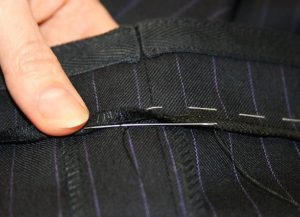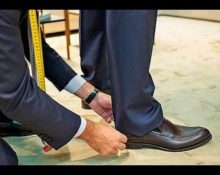 It happens that when buying clothes, a person may miss the size. Or when ordering an item, there is a possibility that it will not fit the parameters. And it very often happens that trousers are several centimeters longer than necessary. This situation can be easily corrected at home. How? Read more in this article.
It happens that when buying clothes, a person may miss the size. Or when ordering an item, there is a possibility that it will not fit the parameters. And it very often happens that trousers are several centimeters longer than necessary. This situation can be easily corrected at home. How? Read more in this article.
Shorten pants without cutting
There are several ways that allow you to change the length of your pants without the intervention of scissors. Let's consider the main ones:
- Classic hand hemming. It is convenient because this option does not require special devices. All you need is a thread and a needle.
- On a sewing machine. This option differs significantly from the first in execution speed. For reliability, it is possible to use a double seam even on trousers with thick fabric.
- Using adhesive tape. This method can be used in cases where the length needs to be changed slightly and in a short time. Moreover, you can reduce the length to the original one.
Materials and tools
To hem your trousers yourself, you will need:
- sewing machine;
- needle;
- threads (it is important that they match the color of the fabric);
- the trousers themselves;
- a piece of soap or chalk;
- scissors;
- ruler, maybe a measuring tape;
- trouser braid;
- pins.
Preparing the trousers
First you need to figure out the size of the hem. Wear the trousers and shoes with which you plan to wear this item. Fold the bottom of the product so that approximately 1 - 1.5 centimeters remain to the floor. Secure with needles. Try walking around the room, sitting on a chair several times so that the clothes rise to their usual height.
Ideally, the trousers should reach the middle of the heel. Highlight with chalk. Do the same steps with the second pant leg.
Hem trousers without cutting them by hand
First option:

After you have placed the very bottom of the trousers, you need to hem 4 millimeters with a straight stitch. Make a fold on the trouser leg so that the length is exactly at the level of the mark.
IMPORTANT! Make sure that the end of the fabric does not protrude below two millimeters of the fold.
It doesn't have to be ironed. It's better to just pin it with pins. Next, follow the same procedure with the second leg. If you hemmed for growth, then you can easily undo the stitches. If dust accumulates in the folds, you should wash the trousers in warm water or clean them with a brush. Following this, iron the bottom. There won't be a trace left!
Second option:
If you need to tuck a small amount of fabric, then you can rip open the factory seam and steam this area. All kinds of creases should be removed using an iron and high temperature.

Set aside 4 cm from the line you created. Based on the first mark, repeat with the second leg.Transfer the line that was drawn with chalk to the next side using pins. Along this straight line, fold the fabric inward and pin. Make sure that the side seams are aligned. A small and thin needle is suitable for sewing. Hem over the edge of the cut using any blind stitch. Use a needle to grab one thread at a time.
You can secure a small hem with adhesive tape by inserting it and applying it with a hot iron.

Correctly hem long trousers without cutting them using a sewing machine
Classic (school) trousers with braid

- To begin with, you should apply the top side of the tape so that it is exactly at the level of the line marked with chalk.
- Then conditionally divide it in half and secure with pins.
- Back off one millimeter.
- Sew the side that matches the chalk line. And only then can you proceed to the bottom.
- You should turn the seam allowance so that it is inside out.
- Don't forget the braid. It should not be visible from the front side.
- Sew the bottom edge yourself or use pins.
- All that remains is to attach the hem to the bottom of the trousers using hidden seams, which will avoid trimming.
- We remove all the basting.
- Finally, we again steam the fabric for a decent appearance.
Jeans
- Fold the trouser leg to a height of one and a half centimeters (two turns).
- Again, remember that the tone of the thread should be observed: it should match the tone of the factory fabric.
REFERENCE! Since we are working with jeans, make a double seam. Sew with a straight stitch.

If you need to preserve the factory seam, then use the following hemming algorithm:
- As in other cases, determine the desired length of the jeans and mark with chalk.
- After measuring the edge, move the mark to the required distance.
- Match the edge and line using the crease of the pants.
- Make a stitch on a sewing machine.
- Thanks to the iron, you can attach the lapel to the pant leg.
- All that remains is to lay the line.
Some tips

- Since some materials tend to shrink after washing, it is recommended to wash the item before starting work to avoid unpleasant consequences.
- If you are working with jeans, you should leave a margin of about one centimeter.
- For summer trousers, braid is used only on the back side, and the allowance is less than a centimeter.
- Soap marks are easier to get rid of than chalk marks.
- If sewing is urgent, you can use double-sided interlining. It is worth understanding that this solution is temporary. However, to use it, you need to apply the tape to the work area - fold it and steam it on one side. Next, fold the other edge and do the same on the other side.
- For knitwear and jeans, you can use special needles and threads.
- If the needle is already rusty, it should be replaced.
- For products made from fabric that has decorative elements, you can shorten it at your own seams.
- After the marks are applied, it is better to cut off the pants on a flat surface.
- Make sure that the seams are not visible.
- In order for classic trousers to look as decent as possible, the back of the legs should be slightly longer than the front, which covers only 2/3 of the shoe.
- If you choose the right length, the trouser leg gathers at the shin into a fold.


 0
0





